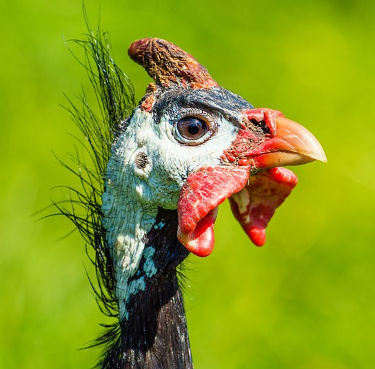Male Guinea fowls

The male of the guinea fowl is called the cock, same as in chickens. They have large eyes, raw red wattles and a little protrusion on the top of their heads which is called a helmet and superficially the male and female look almost exactly the same. In the chicken world this is called hen feathering where the feathers are the same in both sexes.
Males prefer to keep the same mate if they can but will fertilise up to six hens if they are the only one in the flock.
Below: A male Guinea fowl.

Are male Guinea fowl aggressive?
Guinea fowl males are aggressive, especially if there is more than 1 of them or they are in a mixed flock with a rooster, drake or tom turkey.
Guineas have no idea of their own size and will take on anything they fancy. The males in my flock spend quite a lot of time terrorising the roosters, seemingly for fun.
Can you keep Guinea fowl with no males in the flock?
You can keep a flock of Guinea fowl with no males if you want the eggs only. Guineas do not need a male to lay eggs, only fertilise the eggs.
This is the ideal unless you need to breed them as Guinea males are hard work and fight often.
What is the best male to female ration for Guinea fowl?
Ideally the breeding ration for Guinea fowl is one to one but you can get a male bird to mate with up to 6 Guinea hens. They are naturally monogamous birds that prefer to breed for life. For this reason, if you intend to breed Guinea fowl, it’s important that you buy some while they’re young and they will naturally start to partner off.
It’s not easing telling the males and females apart. But if you look and listen closely, you’ll be able to identify the male Guinea fowl by its more prominent wattles and larger helmet.
Another way to tell the difference is to listen to their calls. The male can do just one while the female has two or three more calls. You may be able to recognise them if you spend a lot of time listening.
How many Guinea fowl should I get?
Depends on whether you are keeping them for meat as well as eggs. If you are then as many as you want to eat plus a few to breed from and some egg layers.
I would recommend at least 6 in a group as they are sociable creatures and even in the wild they tend to live in small groups for life. The only time the group splits up is during mating season when the couples need to nest. Guinea Fowl don’t do so well on their own and will grow noticeably depressed as time passes.
They lay about half as many eggs as good laying chickens and the eggs are smaller. they are also seasonal layers. I find I need about three times as many Guinea fowl as chickens.
